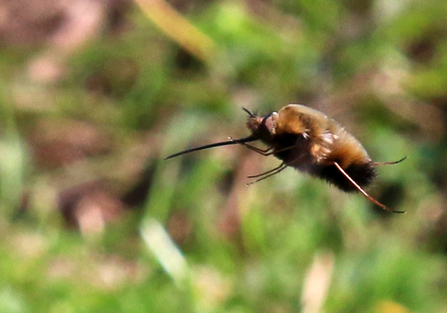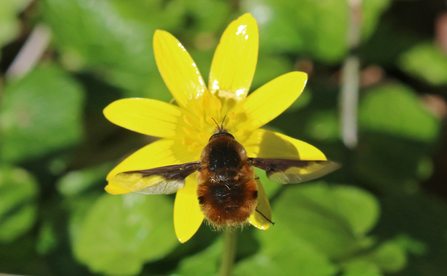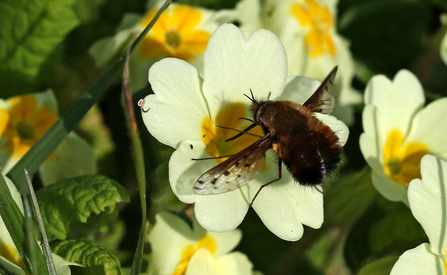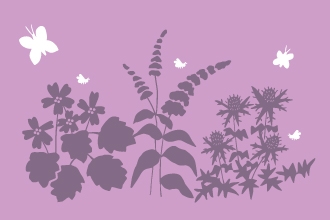Flies. A word that evokes annoyingly buzzing creatures that fly around the house or land on your food. Flies are so much more than that, though, so let's take a glimpse into the amazing world of these two-winged creatures. Flies come in all sorts of shapes, sizes and colours and they're not only important pollinators but the larvae of some species eat garden and farm pests so they're useful to have around.
Buzzy bee-flies
Dotted bee-fly feeding on green alkanet by Wendy Carter

Dotted bee-fly by Wendy Carter
Spring feels like it's taken a while to get going this year but head outside, find yourself a patch of primroses, celandines or lungwort and you might well spot two of the fuzziest flies around - dark-edged and dotted bee-flies. Bee-flies appear to be bundles of fluffy flying joy, looking remarkably like a bee with their fuzzy hair and buzzing nature. Their furry bodies are tipped with a long blade-like proboscis at the front; this is a long stiff sheath to protect a long tongue, which they dip into flowers to sup the nectar. Unlike butterflies who can roll up their proboscises, bee-flies are unable to do this so they have a rather comic appearance as they buzz from flower to flower. They aim the proboscis at the centre of the flower and hover, wings beating quickly, as they drink. If you're able to look closely, you might notice that they often rest their front feet on the flower for extra stability.

Dark-edged bee-fly by Wendy Carter
All is not as it seems in this fluffy joyful world, however. Once mated, the females wiggle their bottoms into a bit of soil or grit to offer a bit of ballast and moisture to their eggs. Then they flick their eggs towards the nests of solitary mining bees. Once the larvae hatch they make their way into the nearest bee nest and, once there, they attach themselves to a bee larvae and suck out their bodily fluids. I'm a big fan of bees so this isn't a behaviour that I appreciate but it's all part of nature's cycle and I console myself by believing that few of the bee-fly eggs will make it into a bee nest in the first place. Relationships like this cause boom and bust cycles for the species involved - one year will see lots of bees, the next will see lots of bee-flies and vice versa in subsequent years.

Dotted bee-fly feeding on primrose by Wendy Carter
Until relatively recently, people in most gardens and greenspaces in Worcestershire would only see one species of bee-fly - the dark-edged bee-fly. These gingery insects are relatively easy to recognise with an obvious dark pattern along the leading edge of the wing. Over the past five or so years, however, a second bee-fly has become widespread in the county. From a handful of records in the south of the county, these ever-so-slightly larger bee-flies have marched (in a flying kind of way) north. It is just about possible to separate dotted bee-flies from dark-edged bee-flies whilst they're buzzing about but to be absolutely sure, a good view of their wings is needed. As the name suggests, look for dots on the wings rather than a dark edge.
So what are you waiting for? Now you know where to look, what they do and how to identify them...head outside and see if you can spot one for yourself!




